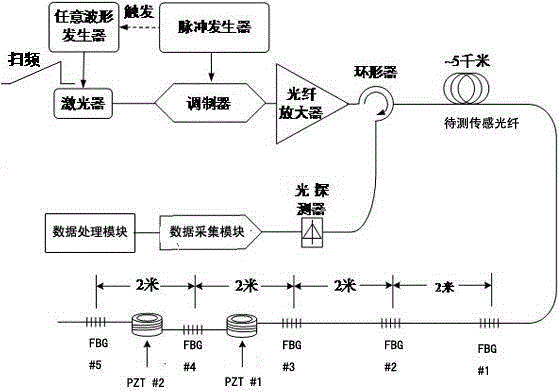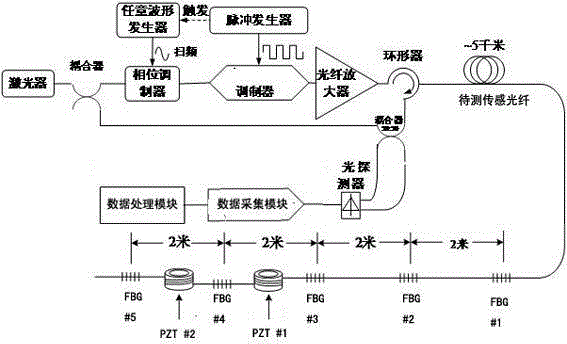Fiber bragg grating array-based phase-sensitive optical time domain reflection device and method
A Bragg fiber, phase-sensitive optical time-domain technology, applied in measurement devices, using wave/particle radiation, and alarms that rely on interfering short-wavelength radiation, etc. Measurements, effects of high spatial resolution measurements
- Summary
- Abstract
- Description
- Claims
- Application Information
AI Technical Summary
Problems solved by technology
Method used
Image
Examples
Embodiment 1
[0037] In this embodiment, the laser frequency adjustment module can adopt time-sweeping demodulation mode, such as figure 2 As shown, the laser frequency adjustment module uses an arbitrary waveform generator and a tunable laser as a light source with a line width of 3.7kHz and a wavelength of 1561.38nm; five FGBs with the same reflectivity of 1% are placed at the end of the sensing fiber , numbered in turn from #1 to #5, and the distance between two pairs is 2m to form a grating array. The signal-to-noise ratio and detection distance can be achieved; the reflection spectrum of the grating in the array should be as wide as possible, and the full-width half-maximum (FWHM) of the reflection spectrum should be at least >1nm; the spacing between the gratings in the array is equal, and the spacing determines the space that the device can reach resolution; the parameters of the fiber grating in the array are the same; even if the above-mentioned fiber grating with extremely weak r...
Embodiment 2
[0057] The difference between this embodiment and Embodiment 1 is that the frequency adjustment module in the device adopts the structure of partial overlapping time sweeping mode, such as image 3 As shown, the laser frequency adjustment module includes an arbitrary waveform generator and a phase modulator, and the arbitrary waveform generator controls the phase modulator to shift the frequency of the continuous light emitted by the light source.
[0058] The modulation process is as follows: a tunable laser is used as the light source, its line width is 3.7kHz, and its wavelength is 1561.38nm; 90% of the light passing through the coupler reaches the phase modulator, and after the laser exits, it passes through a 90:10 coupler, of which 10 % is used as a local oscillator light signal; a modulator with a high extinction ratio is applied to the continuous light output by the laser, and then converted into a detection pulse light with a pulse width of 150 ns, and the modulator su...
Embodiment 3
[0062] The difference between the embodiment of this device and the second embodiment is that the laser frequency adjustment module in the device adopts the structure of completely overlapping time sweep mode, such as Figure 4 As shown, the laser frequency adjustment module includes an arbitrary waveform generator and a phase modulator, and the arbitrary waveform generator controls the phase modulator to modulate the continuous light emitted by the light source.
[0063] The modulation process is as follows: the coherent detection method is selected, and the tunable laser is used as the light source. The linewidth is 3.7kHz and the wavelength is 1561.38nm; 90% of the light passing through the coupler reaches the phase modulator, and the laser passes through a 90 : 10 couplers, 10% of which are used as local oscillator optical signals; a high extinction ratio pulse modulator is applied to the continuous light output by the laser, and then converted into photodetection pulsed li...
PUM
 Login to View More
Login to View More Abstract
Description
Claims
Application Information
 Login to View More
Login to View More - R&D
- Intellectual Property
- Life Sciences
- Materials
- Tech Scout
- Unparalleled Data Quality
- Higher Quality Content
- 60% Fewer Hallucinations
Browse by: Latest US Patents, China's latest patents, Technical Efficacy Thesaurus, Application Domain, Technology Topic, Popular Technical Reports.
© 2025 PatSnap. All rights reserved.Legal|Privacy policy|Modern Slavery Act Transparency Statement|Sitemap|About US| Contact US: help@patsnap.com



